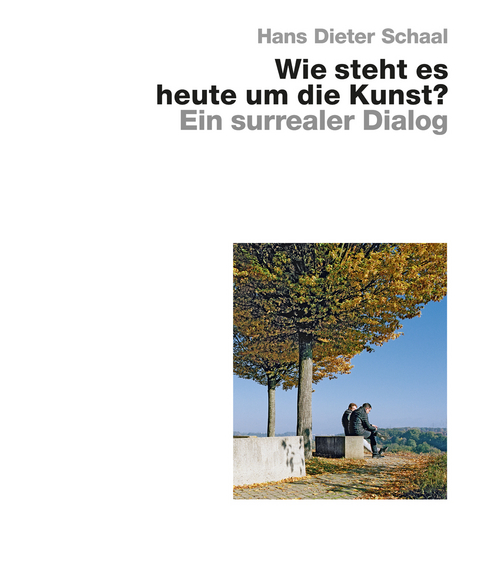
Wie steht es heute um die Kunst? – Ein surrealer Dialog
Seiten
2025
Edition Axel Menges (Verlag)
978-3-86905-039-3 (ISBN)
Edition Axel Menges (Verlag)
978-3-86905-039-3 (ISBN)
- Noch nicht erschienen (ca. März 2025)
- Versandkostenfrei
- Auch auf Rechnung
- Artikel merken
The scene: a retirement home with a care centre
and a ward for the mentally disturbed. Most
of them in open zones, only a few in closed
zones. Some have strange tics and habits.
Some are haunted by their nocturnal dreams,
others, like Mr B, by the obsessive idea that
art and art history have come to an end worldwide.
Only religions could save them. Mr A is
more open-minded than Mr B. But he also has
his nightmares and suffers from isolation. Both,
you could say, are addicted to their daily discussions,
which sometimes escalate into arguments
and then end in reconciliation.
It’s late summer. When the sun is shining in
the afternoon, the residents of the institution can
watch from their balconies or from the café as
the two elderly men, Mr B and Mr A, set off for
their daily garden rounds around 3 pm, sitting
on their bench for a longer time.
Mr B was a heavy smoker and drinker. He is
in the process of kicking all his unhealthy habits,
with the help of therapists and doctors. Hard
work against his own body. In real life, he used
to be a teacher at a grammar school. His subjects:
German and art.
Mr A has a small moustache under his nose.
He walks a little more crooked and stooped than
Mr B. His life was well-behaved and bourgeois.
He was a good pupil and student. After graduating
from high school and studying architecture,
he decided to become a civil servant and
applied for a job with the city. He was hired without
any problems and soon became head of
the building permit office.
Every day, one of the two gentlemen, usually
Mr B, brings a small piece of paper with a quote
from an artist or philosopher to the meeting.
Their conversations oscillate between seriousness
and fun, between exaggeration and irony,
between play and pure entertainment, between
Plato and Heidegger, between Karl Valentin and
current, meaningless politicians, between TV talk
shows, adult education course topics and regulars’
table gossip. We accompany the two gentlemen
for seven days, then it’s over. A slice of
time. A slice of life. A slice of reality
and a ward for the mentally disturbed. Most
of them in open zones, only a few in closed
zones. Some have strange tics and habits.
Some are haunted by their nocturnal dreams,
others, like Mr B, by the obsessive idea that
art and art history have come to an end worldwide.
Only religions could save them. Mr A is
more open-minded than Mr B. But he also has
his nightmares and suffers from isolation. Both,
you could say, are addicted to their daily discussions,
which sometimes escalate into arguments
and then end in reconciliation.
It’s late summer. When the sun is shining in
the afternoon, the residents of the institution can
watch from their balconies or from the café as
the two elderly men, Mr B and Mr A, set off for
their daily garden rounds around 3 pm, sitting
on their bench for a longer time.
Mr B was a heavy smoker and drinker. He is
in the process of kicking all his unhealthy habits,
with the help of therapists and doctors. Hard
work against his own body. In real life, he used
to be a teacher at a grammar school. His subjects:
German and art.
Mr A has a small moustache under his nose.
He walks a little more crooked and stooped than
Mr B. His life was well-behaved and bourgeois.
He was a good pupil and student. After graduating
from high school and studying architecture,
he decided to become a civil servant and
applied for a job with the city. He was hired without
any problems and soon became head of
the building permit office.
Every day, one of the two gentlemen, usually
Mr B, brings a small piece of paper with a quote
from an artist or philosopher to the meeting.
Their conversations oscillate between seriousness
and fun, between exaggeration and irony,
between play and pure entertainment, between
Plato and Heidegger, between Karl Valentin and
current, meaningless politicians, between TV talk
shows, adult education course topics and regulars’
table gossip. We accompany the two gentlemen
for seven days, then it’s over. A slice of
time. A slice of life. A slice of reality
Hans Dieter Schaal, born in Ulm in 1943, is an architect, landscape designer, stage designer, exhibition designer and freelance artist. His works, the majority of which have been published by Edition Axel Menges, have found an audience far beyond his home country. Schaal lives and works in a village near Biberach an der Riß.
| Erscheint lt. Verlag | 30.3.2025 |
|---|---|
| Verlagsort | Stuttgart |
| Sprache | deutsch |
| Maße | 210 x 248 mm |
| Themenwelt | Kunst / Musik / Theater ► Malerei / Plastik |
| Schlagworte | Architektur • Kunst • Malerei |
| ISBN-10 | 3-86905-039-X / 386905039X |
| ISBN-13 | 978-3-86905-039-3 / 9783869050393 |
| Zustand | Neuware |
| Informationen gemäß Produktsicherheitsverordnung (GPSR) | |
| Haben Sie eine Frage zum Produkt? |
Mehr entdecken
aus dem Bereich
aus dem Bereich
Wie viel Kindheit steckt in Kunst?
Buch | Hardcover (2023)
starfruit publications (Verlag)
CHF 36,90
die Entdeckung der Sächsischen Schweiz im 18./19. Jahrhundert
Buch | Softcover (2023)
Verlag der Kunst
CHF 22,90


